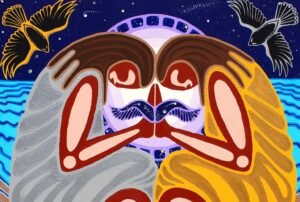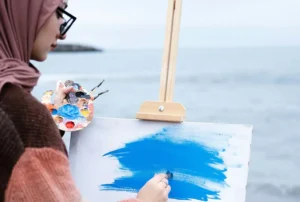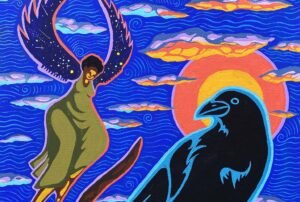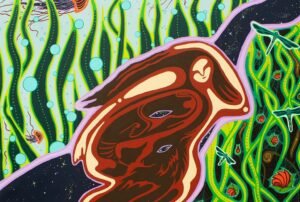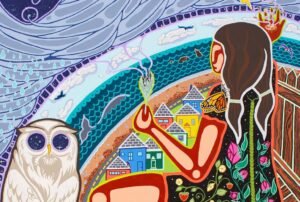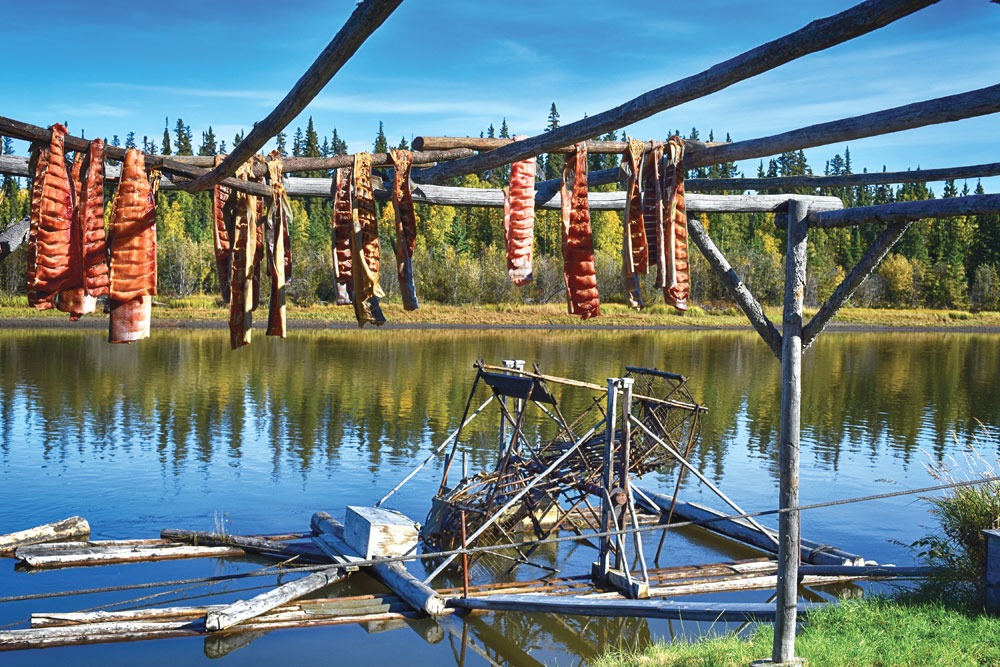
This article from the fall 2020 edition of the Nonprofit Quarterly is part of a series of works on the subject of environmental justice and Indigenous communities in the United States, curated by Raymond Foxworth of the First Nations Development Institute. You can read others here, here, and here.
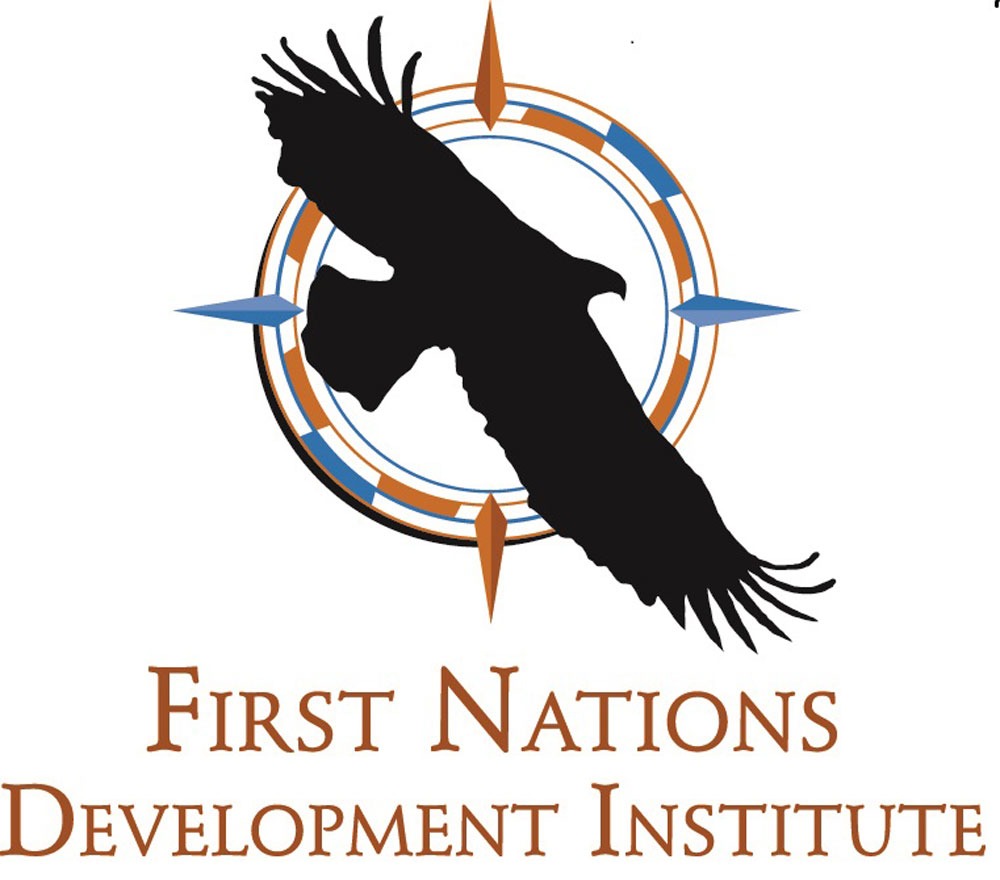
Alaska native peoples were stewards of this place we call home for more than ten thousand years prior to contact with Europeans. Despite centuries of colonization, our Alaska Native bloodline remains one of strength—evolving still today as we adapt to new ways of survival in our changing natural, cultural, and built environments. We find each other and become united in our fight to overcome the multiplicity of attempts to dismantle our ways of life through the generations of colonization, disease, and now climate change. We find each other, and we link arms.
Moving Back to an Ecosystem that Provides for Balance and Harmony
Alaska has been described as the “The Last Frontier”—a “wild” and “rugged” landscape “unknown” and “uncharted” by those living in what we refer to as the Lower 48. Alaska became a state in 1959; prior to that, our Alaska Native ancestors lived in reciprocity with the environment and animals, without a hierarchical system in which one species dominates another but rather living within an ecosystem that provides for balance and harmony. As the First Peoples of these lands, for centuries we have shared and continue to share land and water with a vast range of relatives, including bears, deer, sheep, moose, caribou, wolves, whales, fish, seals, and many other species of wildlife. We are also blessed with tundra, plant medicine, and berries, cedar, roots, and other wild trees and plants essential to our health and livelihood.1
Alaska is home to eleven distinct and diverse Native cultures, including numerous subcultures with differences in dialect, cultural activities, and traditional ways of life.2 The eleven different cultures speak over twenty distinct languages and include 229 federally recognized Tribes, which constitute roughly half of all federally recognized Tribes in the United States.3 Our Tribes are ethnically, culturally, and linguistically diverse nations, occupying an area of about 365 million acres—more than the combined area of the next three largest states: Texas, California, and Montana. While Alaska Native people once stewarded the entirety of what is now Alaska, the amount of land in Tribal ownership now is just a small fraction compared to that owned by federal and state governments, churches, private entities, and Alaska Native corporations.
Alaska is bounded on three sides by water, and has a coastline that stretches about 6,600 miles (excluding island shorelines, bays, and fjords). This accounts for more than half of the entire U.S. coastline in totality, and these areas range from rocky shores, sandy beaches, and high cliffs to river deltas, mud flats, and barrier islands. The coastline constantly changes due to wave action, ocean currents, storms, and river deposits, and is subject to periodic, severe erosion. Alaska also has more than twelve thousand rivers, including three of the ten largest in the country—the Yukon, Kuskokwim, and Copper Rivers. While these and other rivers provide food, transportation, and recreation for people, as well as habitats for fish and wildlife, their waters also shape the landscape and harvesting patterns. In particular, ice jams on rivers and flooding of riverbanks during spring breakup change the contour of valleys, wetlands, and human settlements.4
Like elsewhere in our country, the federal government has recognized Alaska Tribes as sovereign nations.5 Notwithstanding federal recognition, the United States has not worked with Tribes in a government-to-government fashion. Colonial government systems continue to criminalize our customary and traditional ways of life. Alaska’s laws and state constitution do not recognize Tribal sovereignty or our customary and traditional life ways, forcing us to fight for our rights to steward our own lands, animals, and waters. Instead, state government and educational systems recognize non-Native “pioneers” and more recent newcomers as key figures in Alaska’s history, essentially leading to Indigenous erasure.
Despite this blatant erasure, Alaska’s Indigenous population comprises roughly 24 percent of the state’s population6 and roughly 17 percent of the voting population—but we continue to experience underrepresentation across our elected and appointed leaders in our state, a reality we share with other American Indian Tribes across the United States.7 Thankfully, our voices have not been silenced, because our people are strong, as history has proven. Our cultural knowledge and community connections have endured. As we strive to protect our homelands from the effects of climate change, we will continue to exercise our rights and use our voices as our Elders have taught us. Our strength is needed now more than ever.
As our Elders predicted, we are living in unprecedented times, as climate change devastates the planet. In Alaska, droughts and wildfires are occurring in the Tongass National Forest (America’s largest rainforest, with approximately 17 million acres); severe coastal and river erosion is forcing villages to relocate; warming water temperatures are causing massive die-off of chum salmon before they have a chance to spawn; and ice and glaciers are melting at alarming rates, adding to the potential for a large tsunami.8 All of these cause-and-effect, human-driven impacts need swift and bold action. The animals, waters, and lands are in trauma.9 Yet today, in 2020, we continue to have elected leaders who hesitate or outright refuse to admit that climate change is human-caused, or even acknowledge that it is happening at all.
Instead of faltering through fear, stumbling to act, or ignoring altogether this dark reality, we can embrace the values of Alaska Natives to help us restore balance: returning to an Indigenous worldview consisting of a paradigm grounded in spirituality and a belief that “we inhabit a living world in which all things are related.”10 The fundamental postulation is that everything has an animating spirit; and people, plants, animals, and the landscape are to be understood in terms of that spirit.11 As such, there is a responsibility that flows from humans to the earth through the act of reciprocal relationships.12 This is done through the construction of an intricate, subsistence-based worldview.13
Original Stewards and Ecologists
Subsistence refers to the complex set of cultural relationships that make up a worldview based upon traditional knowledge of the natural world.14 Traditional laws were passed from generation to generation, intact, through the repetition of legends and observance of ceremonies, and is largely concerned with the use of the land, water, and the resources contained therein.15 Subsistence living is not only a way of life but also a life-enriching process.16
The traditional economy of Alaska’s Indigenous peoples is based on subsistence activities that require special skills and a complex understanding of the local environments that enable people to live directly from and with the land.17 These skills, passed down from generation to generation, enabled people and their environments to live in symbiotic relationships with one another. The traditional subsistence economy is predicated on a reverence for cultural values and knowledge that Elders and culture bearers have passed down to younger generations, and which continues to this day. While technological advances have been made that have altered some traditional subsistence practices and livelihoods, the underlying values, principles, and cultural significance remain the same.
Subsistence livelihoods also involve cultural values and attitudes: mutual respect, sharing, resourcefulness, and an understanding that is both conscious and spiritual—the intricate relationships that link humans, animals, and the environment.18 Unlike the Western tradition, in which there is a recognized hierarchy of beings, with human beings on top, the Indigenous worldview reveres all life equally, in coexistence.
Anthropologists have called Indigenous peoples the “original ecologists.”19 Indigenous peoples were able to sustain their traditional subsistence economy for millennia because “they possessed appropriate ecological knowledge and suitable methods to exploit resources, but possessed a philosophy and environmental ethic to keep exploitive abilities in check, and established ground rules for relationships between humans and animals.”20
Native peoples’ reciprocity with the natural and spiritual realms ensures that a sacred relationship and balance are maintained—a form of cross-species interaction and dependence that is now being recognized by Western science, in the field of ecology, which studies the interactions between living things and their environments. The concept of ecology and the framing of “ecological democracy” are derived in part from the wisdom of Indigenous peoples that “everything is connected….Every part of an ecology is connected to, and has impacts on, every other part.”21 The merging of science and Indigenous worldviews is finding voice. As Indigenous author and scholar Robin Wall Kimmerer declares, “I dream of a world guided by a lens of stories rooted in the revelations of science and framed with an indigenous worldview—stories in which matter and spirit are both given voice.”22
Armed with a worldview and philosophy that humans are stewards of the land, Alaska’s Indigenous peoples are on the front line of climate justice—pushing back against extractive development projects that would contribute to global climate change and destroy aquatic systems and terrestrial habitats that provide sustainable livelihoods. Three examples illustrate Native environmental justice efforts in Alaska.
1. The Ch’u’itnu drainage. There has been a successful effort to stop a planned surface coalmine in the Ch’u’itnu (Chuitt River) drainage of Cook Inlet, Alaska. The Ch’u’itnu drainage supports all five stocks of salmon species, and constitutes a Traditional Cultural Landscape (TCL) associated with the Indigenous Tyonek Dena’ina, or Tubughna, people.23
PacRim Coal, LP, proposed a surface coal mine about twelve miles inland from the village of Tyonek that would remove and market an estimated 300 million tons of subbituminous coal from the Ch’u’itnu watershed.24 The depth of the proposed mine would be up to 350 feet, directly through a salmon stream. The plan was to completely remove eleven miles of streambed and more than three hundred feet of underlying soil and rock strata.25 Because construction of the mine would require alterations to waters of the United States, the project could not be undertaken without a permit issued by the U.S. Army Corp of Engineers, under the Clean Water Act.26
The Tyonek community opposed the development of the mine on the basis that it would destroy the Ch’u’itnu watershed, the salmon and other resources that it sustains, and the lifeways of the Tubughna people. Via a petition to the National Register of Historic Places, Tyonek showed that the Ch’u’itnu watershed qualified as a living cultural landscape, and was therefore eligible for listing.27
Tyonek’s petition was unique in that it relied on data and information derived from the Tubughna worldview. With the help of anthropologists, Tyonek’s narrative described the historical pattern of salmon subsistence and how it influenced and continues to influence Tubughna spiritual beliefs.28 Such beliefs reflect deep associations with the landscape and its wild animals and plants, each of which is understood to have will and to interact with humans willingly.29
On April 17, 2017, the mine developer announced that it was suspending permit efforts for lack of investment.30 The drop in the price of coal, coupled with the closing of coal plants and fierce local opposition from environmentalists and the Tyonek Tribe, created an unfavorable market for the development of a strip mine.
2. The Bristol Bay watershed. Tribal advocates in the Bristol Bay area are likewise pushing back against the development of a large-scale mine, in this case at the headwaters of the Bristol Bay watershed, one of the most pristine ecosystems left in the world.31 The watershed’s streams, wetlands, and other aquatic resources support world-class, economically important commercial and sport fisheries, as well as a more than 4,000-year-old subsistence-based way of life for Alaska Natives.32 The Pebble Mine deposit is a large, low-grade copper deposit, and is likely to involve excavation of the largest open pit ever constructed in North America.33 In assessing the potential mining impacts on salmon ecosystems of Bristol Bay, the EPA conducted numerous hearings and listened to hours of testimony from Native people in twenty-five villages located in the Bristol Bay watershed. The EPA summarized its findings as follows:
Salmon are integral to these cultures’ entire way of life via the provision of subsistence food and subsistence-based livelihoods, and are an important foundation for their language, spirituality, and social structure. The cultures have a strong connection to the landscape and its resources. In the Bristol Bay watershed, this connection has been maintained for at least 4,000 years and is in part both due to and responsible for the continued undisturbed condition of the region’s landscape and biological resources. The respect and importance given salmon and other wildlife, along with traditional knowledge of the environment, have produced a sustainable subsistence-based economy. The subsistence-based way of life is a key element of Alaska Native identity and serves a wide range of economic, social, and cultural functions in Yup’ik and Dena’ina societies.34
Based on the strength of Indigenous testimony and upon a finding that the cumulative impact of the mine would detrimentally affect the watershed, in 2014 the EPA released a proposed determination that would restrict discharge of dredged or fill material related to the mining of the Pebble Mine deposit.35 But in 2019, the Trump administration withdrew the proposed restrictions, with instructions to fast track the permit process.36 Consequently, the Pebble Mine project has become highly political, and the outcome of whether it goes forward or not will depend on the next presidential election.37
3. The Arctic National Wildlife Refuge’s coastal plain. Another Indigenous campaign to push back against extractive development involves the Gwich’in Tribes, who live just north of the Arctic circle. The Gwich’in are the northernmost Indian nation, living in fifteen small villages scattered across a vast area extending from northeast Alaska in the United States to the Northern Yukon and Northwest Territories in Canada. The word Gwich’in means “people of the land.”38 Oral tradition indicates the Gwich’in have occupied this area since time immemorial.39
In 2017, Congress enacted tax reform and appropriation legislation that contained a provision opening the Arctic National Wildlife Refuge’s coastal plain to oil and gas development.40 The Refuge’s coastal plain is home to the calving grounds of the Porcupine Caribou Herd—one of the largest wild herds in the world—and serves as a source of great cultural importance to the Gwich’in Tribes of Alaska, who refer to the area as “Iizhik Gwats’an Gwandaii Goodlit” (“The Sacred Place Where Life Begins”).41
The Gwich’in Tribes have an intimate relationship with the Porcupine caribou. As Gwich’in Elder Sarah James explains, “We are caribou people. Caribou are not just what we eat; they are who we are. They are in our stories and songs and the whole way we see the world. Caribou are our life. Without caribou we wouldn’t exist.”42
Like the Tubughna, Yup’ik, and Dena’ina Tribes of Bristol Bay, the Gwich’in Tribes reject development at the cost of damage to the land and waters and the sustainable life they support. Each Tribe draws from its traditional knowledge—gained from millennia of experience and relationship with the natural world, and passed from generation to generation—that teaches that we are stewards, we are caretakers, and we have an obligation to protect the earth. These values are the lifeblood of our Tribal education, governance, familial, spiritual, social, and individual systems.
Climate Change Impacts
But the ultimate challenge to our survival and collective well-being is upon us in the form of climate change, coupled with one dominant culture suppressing others. Because we have burned fossil fuels relentlessly for ravenous economies and exploding populations, Earth has entered a new geologic era.43 Due to the consequences of overextraction, overconsumption, and carbon emissions from the use of fossil fuels, we now have to confront the certainty of climate change. Indigenous communities in Alaska tend to be disproportionately exposed to its effects, which are having multigenerational and cultural impacts.
Sign up for our free newsletters
Subscribe to NPQ's newsletters to have our top stories delivered directly to your inbox.
By signing up, you agree to our privacy policy and terms of use, and to receive messages from NPQ and our partners.
The tiny Inuit village of Kivalina, on the Chukchi Sea in Northwest Alaska, is among those that are dealing with relocation efforts due to climate change.44 Kivalina residents are Inupiat (Inuit), whose ancestors came to the narrow spit of land they now occupy in the early 1940s, when they were ordered to settle there permanently and enroll their children in school or face imprisonment.45
As people in-migrated to Kivalina, the federal government provided little more than a school and schoolteacher. Over time, federal—and, eventually, state—government agencies began to provide services to the people of Kivalina: an airport was put in; massive fuel tanks were barged in to hold a winter’s worth of fuel oil; public water and waste facilities were developed; a health clinic was established; and a new school was built. Even with all of these adaptations to modern Western living, the people of Kivalina still maintained their subsistence way of life.46
A number of years ago, the people of Kivalina started seeing changes in their environment that were apparent to all but difficult to grasp. Sadly, the changes were beyond what Elders had previously experienced, and they were of an extraordinary nature. People witnessed firsthand: rain in January, in what was otherwise a month characterized by -50°F temperatures; Pacific salmon making their way to waters typically too cold for them to spawn in; grizzly bears moving north into polar bear habitat; and polar bears staying on vast land rather than risk moving onto sea ice that threatened to break apart with the first strong wind. People witnessed winter storms of unprecedented force and gigantic sinkholes from permafrost that seemed to appear out of nowhere.47
For Inuit peoples, sea ice is a critical part of the natural world. It allows for safe travel on perilous Arctic waters and provides a stable platform from which to hunt its bounty.48 The ice, once it has frozen solid, serves not only as a road for winter travel but also a critical grocery store. Deteriorating ice conditions imperil life in many ways. Ice pans, used for hunting at the floe edge, are more likely to detach from the land, setting hunters adrift. Many hunters have been killed or seriously injured from falling through ice traditionally known to be safe.49 Thinner ice also means much shorter hunting seasons, as the ice forms later and melts sooner. In turn, not only humans but also many ice-dependent species are experiencing adverse impacts.50
Retreating sea ice and thawing permafrost have exposed Kivalina to erosion from Arctic storms, which have become fiercer and more frequent than in the past.51 The four hundred village residents have watched one end of their village being eaten away, losing as much as seventy feet of land overnight in one storm.52 In the past thirty years, one hundred feet of coastline has washed away.53 An investigation by the U.S. General Accounting Office, an investigative arm of Congress, found that 184 out of 213 Alaska Native villages (86.4 percent) experience some level of flooding and erosion.54
The cost of relocating these villages will be high, ranging from $100 million to over $400 million.55 And while Kivalina residents voted to relocate the community several years ago, they lack the many millions of dollars such a move would cost. For now, Kivalina, and other Alaska Native villages the federal government have found to be “imminently threatened,” must remain where they are, exposed to the consequences of climate change, until there is a commitment from the federal government to extend the resources necessary to relocate.56
Indigenous Just Transition Framework
In addition to attention to and adequate resources for dealing with the climate change impacts Alaskans are facing, an Indigenous just transition framework is needed to help guide climate-change adaptation actions that ensure durability and successful outcomes. The Indigenous Just Transition framework, recently created for similarly situated Tribes, was developed collectively among Indigenous leaders, experts, and allies to guide what we are working toward at Native Peoples Action and Native Peoples Action Community Fund (NPA/NPACF). Offered as a vision to help with the transition away from current threats, the framework’s success will depend heavily on local community and Indigenous buy-in and ownership of the plan and the process.
Just Transition is about revitalizing the Indigenous worldviews that have been colonized and assimilated—stolen from traditional societies and cultures. The framework guides our climate justice strategy, and is founded on our Indigenous worldviews. We are redefining, or returning to, a more “true” economy by centering our core values: our home, traditions, and spirituality. We need an economy that is in alignment with what the earth provides and that ensures an economic shift that is fair and equitable for all. We do this work through the same principles of respect and honor learned from our traditional knowledge system. Our ancestral connection to the lands and waters uplifts us and all of our languages and cultures. With this as our foundation, we are able to work on the many important issues around our state.
Alaska is experiencing an unparalleled moment of systemic political, economic, and ecological crisis—one that has required Alaskans to rethink how we balance our current and future needs. The economic system that has sustained Alaska for over forty years is unraveling. Since the 1970s, an oil-based economy has dictated the speed and sectors of business growth. Alaska is lagging behind in the global movement to reorient economies away from declining extractive resources. Just Transition is a framework for a fair shift to an economy that is ecologically sustainable, equitable, and just for all Alaskans. We know that transition is inevitable—but justice is not.57
Implementing an Indigenous just transition framework requires a shift in consciousness within and across federal, state, and local governments, as well as the philanthropic sector. Any funds dedicated to climate change adaptation, environmental justice, protection strategies, food security, and sustainability need to go directly to Indigenous and locally derived solutions—solutions envisioned by local and Indigenous citizens and leaders, based on their own scientific observations, wisdom, responsibility, and commitment to future, current, and past generations.
By funding local and Indigenous visions directly, instead of making them fit into a prescribed philanthropic or government mold, we enter into a self-determination model that has sound results, demonstrated by our robust Alaska Native Tribal Health system.58
This collective shift in consciousness is how we are going to move into the next decade and beyond. Philanthropy and government can either get on the train or fall off through irrelevance. With the collective power we still retain, let us shatter the illusions, which are a by-product of commodification, wealth, extraction, short-term thinking, hierarchy, and a culture of dominance and oppression. As described by Kimmerer:
Children, language, lands: almost everything was stripped away, stolen when you weren’t looking because you were trying to stay alive. In the face of such loss, one thing our people could not surrender was the meaning of land. In the settler mind, land was property, real estate, capital, or natural resources. But to our people, it was everything: identity, the connection to our ancestors, the home of our nonhuman kinfolk, our pharmacy, our library, the source of all that sustained us. Our lands were where our responsibility to the world was enacted, sacred ground. It belonged to itself; it was a gift, not a commodity, so it could never be bought or sold. These are the meanings people took with them when they were forced from their ancient homelands to new places. Whether it was their homeland or the new land forced upon them, land held in common gave people strength; it gave them something to fight for.59
For us in this movement, that means building a regenerative economy and ensuring that local needs are met with global support—and that we seek out and perpetuate interconnectedness in approaching our solutions. Mother Nature, we have been taught, does not see things as good or bad, in black or white. There is simply balance or chaos, equilibrium or disorder.
Let us return to balance.
Let us take a moment, in honor of all those who have come before us, to pledge that the sacrifices and struggles they endured to make our world a better place will take a new form, not worsen or stay the same.
Let us take a moment, too, to recognize that this shift in consciousness that we speak of is the current momentum and trajectory we are already on. As stated by Representative Alexandria Ocasio-Cortez, “There is no justice and there is no combating climate change without addressing what has happened to indigenous communities.”60 Hand in hand with addressing what has happened is honoring and returning to what once was, before interruption.
Kikiktagruk Kotzebue Retreat
In 2016, twenty-five Alaska Natives came together in the city of Kotzebue, at the founding retreat for our NPA/NPACF work, focused on the principles of creating a system that supports collective well-being. They identified five separate elements that embody an Indigenous just transition framework (Be Grounded, Be Sustained, Be Seen, Be Heard, Be Sacred), surrounding a central pinnacle (Be Well)—based on experience and vision:61
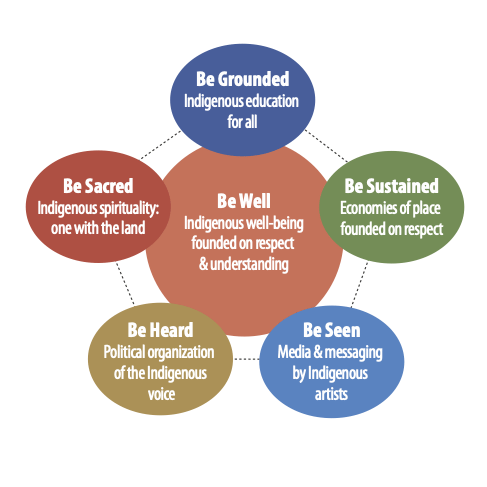
If you have been waiting to be invited, or want some ideas for how to join this movement, let us help you make that happen:
- For starters, learn whose traditional lands you live and work on, and whose traditionally stewarded waterways you benefit from. Dig deeper into the truth and seek to learn beyond what our American education history books, Western research, and the mainstream media are telling us to believe.
- Then, build personal and professional relationships with all kinds of beautiful souls from the non-Western-dominated segments of society. This brings stories and real, lived experiences and new perspectives into your learning journey. This also creates a pathway for you to challenge stereotypes and prejudgments, as you peel back the layers and begin to see how systemic racism and oppression have blinded you. Learn how to say, I don’t know, but I’m here to listen and help.
- Show up for local and Indigenous endeavors, not as a savior but as a supportive ally. “Indigenous Peoples need allies to help secure long-term support for Indigenous-led conservation.”62 The Indigenous Land Needs Guardians program out of Canada offers some tools and actionable recommendations.63
…
It is because of our Indigenous relatives and ancestors that we still remember the ways of our Earth Mother. It is because of our immense love and connection to the seen and the unseen alike that we offer these words as a collective blessing. We offer this to you as an expression of the collective vision shared by Native Peoples Action and Native Peoples Action Community Fund, and to share some of the spark that lit our fire and compelled us forward in this moment and movement.
If you have already shown up and are knee-deep in this work—thank you, we need you.
If you are becoming aware of these things and are on your path to awakening—thank you, we need you.
As people awaken to new values, they can adopt new values. Values inform ways of life. Indigenous ways of life are derived from living in balance with nature, values deeply needed today—for example, values grounded in unconditional love: how to be in service to the community above oneself; how to share; how to feel gratitude and be in relationship with all things.
A Native Hawaiian teaching, offered as a gift for us today as we seek how to move forward, is to recognize that the land is a chief, man is its servant. While it is our cultural values that underpin our Indigenous Just Transition framework, it is our cultural practices that show us how to take care of Mother Earth: as we honor how she cares for us, we begin to return to balance—and in doing so, we protect what we love and each other.
If you are uncompelled or uncomfortable with this invitation and opportunity to learn from and lift up Indigenous worldviews of how to move forward collectively, then you likely have not yet come to understand that we are all equal in the sacred balance of life. There is no room for that, not under our watch—and believe us, we are watching! Our collective vision is inclusive of your well-being; it is our common starting point. Let us begin again through an Indigenous framework, and return to balance.
Social and economic suppression, racial inequality, and other pressing forces largely keep Indigenous stories and solutions out of reach and in the dark—even when desperately sought out and needed. Overcoming this requires fearless leaders and allies who understand how to use, support, and build strong networks, and how to cultivate community partners. This movement—returning to balance—requires us to advance healing and wellness; to restore lands, waters, animals, and people through a cultural lens; to share and champion what can be passed on from Indigenous and Tribal Elders, mentors, and natural environmentalists, and all those who carry geographic intelligence; to move us forward far into the future, another 10,000-plus years. This is what NPA/NPACF’s work is all about.
Thank you in all of our Indigenous languages for reading this and for learning some of our stories. In solidarity, We Warrior Up, We Take a Stand, We Mobilize Action.
Notes
- National Park Service, “Wildlife in Alaska,” accessed August 14, 2020.
- “Overview of Entities Operating in the Twelve Regions,” ANCSA Regional Association, accessed August 14, 2020.
- National Congress of American Indians, Tribal Nations and the United States: An Introduction (Washington, DC: National Congress of American Indians, February 2020), 24.
- Alaska Native Villages: Most Are Affected by Flooding and Erosion, but Few Qualify for Federal Assistance, GAO-04-142, a report to the Senate and House Committees on Appropriations by the United States General Accounting Office (Washington, DC, December 2003), 3.
- National Congress of American Indians, Tribal Nations and the United States, 18.
- Richard Walker, “10 Things You Should Know About Alaska Natives,” Indian Country Today, September 7, 2017.
- National Congress of American Indians, “Every Native Vote Counts: Fast Facts,” accessed August 16, 2020.
- “Tongass National Forest,” Alaska Wilderness League, accessed August 14, 2020. For drought, see Aurora Cutler and Erik Johnson, “Drought In The World’s Largest Temperate Rainforest?,” U.S. Department of Agriculture blog, December 30, 2019; for villages, see Alaska Native Villages: Most Are Affected by Flooding and Erosion, but Few Qualify for Federal Assistance; for salmon, see Carly Roth, “Warming Rivers Are Causing Die-Offs Among Alaska Salmon,” State of the Planet (blog), Earth Institute, Columbia University, September 6, 2019; for tsunamis, see Alex Fox, “Potential Landslide Could Trigger Destructive Tsunami in Alaska, Scientists Warn,” Smithsonian Magazine, May 20, 2020.
- Chris Landry, “Returning to Balance,” July 8, 2020, video, 13:30.
- “Catalyzing Conversation: Alaska Native Wellness and Spirituality” (panel presentation, Jessica Black, moderator, Tribal Governance Symposium, University of Fairbanks, Alaska, November 5, 2019); and see Thomas R. Berger, Village Journey: The Report of the Alaska Native Review Commission (New York: Hill & Wang, 1985), 48–72.
- Angayuqaq Oscar Kawagley, A Yupiaq Worldview: A Pathway to Ecology and Spirit, 2nd ed. (Long Grove, IL: Waveland Press, 2006), 8–11.
- Robin Wall Kimmerer, Braiding Sweetgrass: Indigenous Wisdom, Scientific Knowledge, and the Teachings of Plants (Minneapolis: Milkweed Editions, 2013), 5.
- Kawagley, A Yupiaq Worldview, 8.
- Berger, Village Journey.
- Ibid.
- Ibid.
- Ibid., 51.
- Ibid., 51.
- Ann Fienup-Riordan, Eskimo Essays: Yup’ik Lives and How We See Them (New Brunswick, NJ: Rutgers University Press, 1990), 32.
- Ibid.
- Tim Hollo, “Towards Ecological Democracy—Part 1,” Green Agenda, April 28, 2028.
- Kimmerer, Braiding Sweetgrass, 346.
- Alan S. Boraas et al., The Ch’u’itnu Traditional Cultural Landscape: A District Eligible for the National Register of Historic Places, report submitted by The Native American Rights Fund on behalf of the Native Village of Tyonek, April 3, 2015.
- “Chuitna Coal Mine Prospect,” Ground Truth Trekking, April 8, 2017.
- Ibid.
- Ibid.
- Boraas et al., The Ch’u’itnu Traditional Cultural Landscape.
- Ibid., 90.
- Ibid., 90.
- Zaz Hollander, “Controversial Chuitna coal mine ‘shelved’ after investor backs out,” Anchorage Daily News, April 4, 2017.
- United Tribes of Bristol Bay (website), accessed August 13, 2020.
- Ibid.
- “What did we tell the EPA?,” United Tribes of Bristol Bay and Trustees for Alaska, October 30, 2017.
- United States Environmental Protection Agency, An Assessment of Potential Mining Impacts on Salmon Ecosystems of Bristol Bay, Alaska (Final Report), Executive Summary, EPA 910-R-14-001ES (Washington, DC: United States Environmental Protection Agency, January 14, 2014), 9.
- United States Environmental Protection Agency, “Proposed Determination to Restrict the Use of an Area as a Disposal Site; Pebble Deposit Area, Southwest Alaska,” 79 Fed. Reg. 42314 (July 21, 2014).
- United States Environmental Protection Agency, “Notification of Decision To Withdraw Proposed Determination To Restrict the Use of an Area as a Disposal Site; Pebble Deposit Area, Southwest Alaska,” 84 Fed. Reg. 45749 (August 30, 2019).
- Associated Press, “Biden vows to block Alaska mine project if elected,” August 9, 2020.
- “About the Gwich’in,” Gwich’in Steering Committee, accessed August 13, 2020.
- Ibid.
- Jackie Wattles, “The Senate tax bill would allow oil drilling in Alaskan Wildlife Refuge,” CNN, December 4, 2017.
- “The Coastal Plain—The Sacred Place Where Life Begins,” Gwich’in Steering Committee, accessed August 13, 2020.
- “About the Gwich’in,” Gwich’in Steering Committee.
- Damian Carrington, “The Anthropocene epoch: scientists declare dawn of human-influenced age,” August 29, 2016; and see Jonathan DuHamel, “Welcome to a new geologic era—the Idiocene,” Climate Change Dispatch, December 29, 2015.
- Chris Mooney, “The remote Alaskan village that needs to be relocated due to climate change,” Washington Post, February 24, 2015.
- Christine Shearer, Kivalina: A Climate Change Story (Chicago: Haymarket Books, 2011), 106–107.
- Ibid.
- Ibid.; and Subhankar Banerjee, ed., Arctic Voices: Resistance at the Tipping Point (New York: Seven Stories Press, 2012).
- Ibid.
- Ibid.
- Vera Trainer, Rick Thoman, and Gay Sheffield, “Where the Sea Ice Recedes, So Does an Alaska Way of Life,” New York Times, September 25, 2019.
- Mooney, “The remote Alaskan village that needs to be relocated due to climate change.”
- Shearer, Kivalina, 4.
- Ibid., 5.
- Alaska Native Villages: Most Are Affected by Flooding and Erosion, but Few Qualify for Federal Assistance.
- Ibid.
- Alaska Native Villages: Limited Progress Has Been Made on Relocating Villages Threatened by Flooding and Erosion, GAO-09-551, a report to Congressional Requesters by the United States Government Accountability Office (Washington, DC, June 2009), 16.
- “Alaska’s Just Transition Summit,” Alaska’s Just Transition Collective, accessed August 17, 2020.
- “Indian Health Service & the Trust Responsibility,” Alaska Native Health Board, accessed August 16, 2020.
- Kimmerer, Braiding Sweetgrass, 17.
- Marie Solis, “AOC: Green New Deal Must Repair ‘Historic Oppression’ of Indigenous People,” Vice, February 7, 2019.
- “NPA Community Fund Operating Principles,” Native Peoples Action Community Fund, accessed August 17, 2020.
- “How to be an Ally of Indigenous-led Conservation,” Land Needs Guardians, accessed August 16, 2020.
- Ibid.


